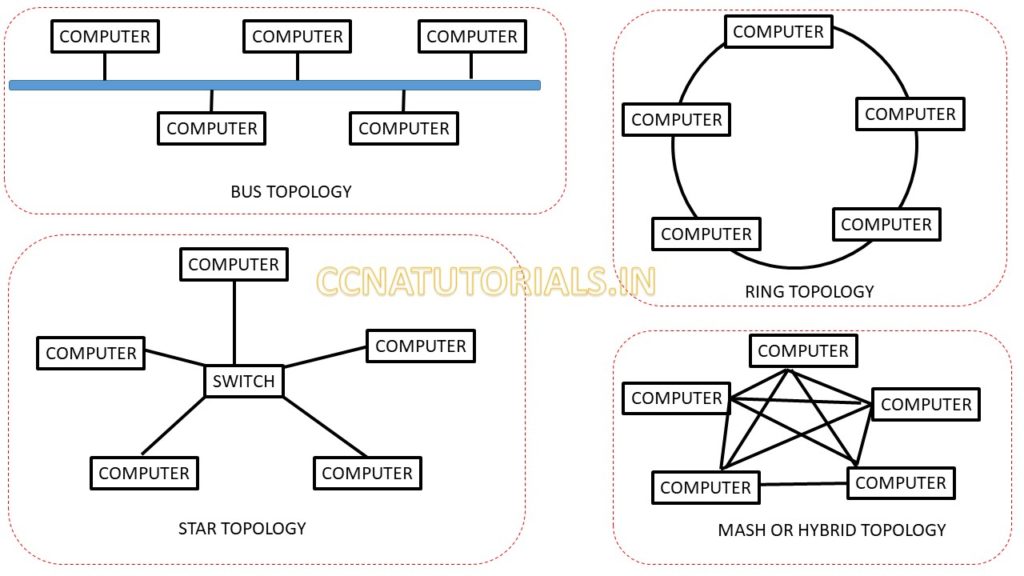In this article I describe the Local Area Network LAN for CCNA Exam. The basics of Local Area Network LAN are very similar to networking basics. There are end point devices, networking devices, some common protocols used by devices. In this article I describe some common terms related to a Local Area Network LAN.
Local area network LAN connects the computers and devices locally with each others via switch or WAP. A Local area network LAN created to share the resources and information within a small network. Local area networks created to share the resources and information within a small network. LAN may be established in a building or in a small campus. In general way we can say that in a LAN all devices are physically accessible.
Devices in a Local Area Network (LAN)
Layer 2 devices used to connect the nodes with each other. Here nodes may be computer, printer, scanner or smart phones. A lots of protocols followed to flow the data in a LAN. The below diagram shows three LAN connected with a Router. All the three LANs are different. Internet can be access in all LANs. WAP can also used in all LAN to connect nodes on Wi-Fi.

The concern of Local Area Network LAN is related to the layout of networking devices and some End point devices. The main purpose of Local Area Network LAN is to share the resources available in the network. For example suppose you have a small network consisting 20 computers for office work. You don’t need to purchase a separate printer for each computer. You can use a single printer for all the devices connected with the network. Similarly you can use a single scanner and other devices with sharing with all computers of the network. To understand IOT it is necessary to understand the networking basics for CCNA

In today scenario some devices supports to work on the internet. For example you have a internet connection in your office and at home too. You can use the devices of your office from your home over the internet. The technology changing day by day. In today scenario the SOHO concept running all over the world. SOHO stands for Small Office Home Office which allow to run a small business from home with online support. SOHO is a best example of a small network or Local Area Network LAN. These all things depends on the latest technology working around us.
Nodes or End Devices in Local Area Network LAN
Nodes is the important term in networking basics for CCNA. The Nodes are the equipment which are connect with some networking devices like hub or switch. The Nodes may be servers, computer, printer, smartphone etc. Nodes are generally identify by network addresses or IP address.
In a Local Area Network LAN devices able to exchange information with each other with the help of switch, router etc. The shared resources may be any application, videos, images, email, data storage, printers etc. Sharing of resources in a network done via flowing of network packets. Nodes are the computers, smartphones in a Local Area Network LAN.
Data Packets flow in Local Area Network LAN
The data flow in the form of Data Packets in a Local Area Network LAN. Data Packets are the main thing to understand in a network. Packets are generate and flow with the help of networking devices. The packet size is define by the networking protocols. The flow and control of packets controls by the protocols used in the network.
Actually the information divided in to packet at source and transmitted. When same packets received at destination packets are reassemble and reform the information. this process known as data transmission in a Local Area Network LAN. Flow of packets depends on the bandwidth of media. Media of sharing information may be OFC, Cat6, WiFi, Bluetooth etc.
Connectivity medium for Local Area Network LAN
The medium used to connect the network nodes is called transmission media. Transmission media are of various types. Some common media are electrical cable, Optical fiber cable, Wireless etc. Ethernet is the common media use for connectivity of network. It is IEEE 802.3 . Ethernet works on electrical and fiber both medium.
Network topology used in Local Area Network LAN
The Network Topology is the physical layout of the Local Area Network LAN. Network topology define that how the nodes are connect with each other in a LAN. The Network topology is the physical layout of network. Network topology are of many types, some of them are Bus, Ring, Star topology.
Each network topology have it’s own pro and cons. Generally mash topology used in most of the networks. Mash topology provides the redundancy for connectivity of devices. If any networking device going to fail the data flow does not interrupted in the network

Some common layouts of Local Area Network LAN
Bus Topology : In Bus Topology all the devices or nodes are connected with a common medium. The main drawback of this topology is that if backbone breaks anywhere full communication will fail. This topology used in layer 2 data link layer of OSI reference model.
Star Topology: In star topology all nodes are connected with a common networking device like switch. The best example of star topology is WLAN. In WLAN all nodes are connected to a Wireless access point. This is the mostly used topology in today scenario.
Ring Topology : In ring topology all nodes are connected with each other like hand to hand a big human circle. Each node connected to next node. All the nodes are connected like a circle. The best example of Ring Topology is FDDI.
Mesh Topology : Mesh topology is also called hybrid network topology. In Mesh topology all the nodes are connected with each other. Mesh topology is created to achieve that at least one node should be always connected with any node.
Some common Protocols used in Local Area Network LAN
IEEE 802
IEEE 802 is a family of IEEE standards dealing with local area networks. It works on physical and data link layer in OSI reference model.
Ethernet
Ethernet is IEEE 802.3 standard. The Ethernet used a 4 pair UTP cable. RJ 45 connector used for connection in a network via Ethernet. It is also called LAN. Brief description of Ethernet will be discussed later. This article is about only networking basics.
Wireless LAN
Wireless LAN, also widely known as WLAN or WiFi, is the mostly used in present scenario. It belongs to IEEE 802 protocol. Mostly end devices are used WLAN to access the network.
Internet Protocol Suite TCP/IP used in Local Area Network LAN
The Internet Protocol Suite, also called TCP/IP is mostly using protocol in present time. It is different from the OSI reference architecture. Some layers of OSI architecture merged for TCP/IP. TCP/IP support connection oriented and connection less services. It uses IPv4 and IPV6 for addressing system.
Personal area network
A personal area network (PAN) is a type of computer network. PAN is used for using the devices belongs to one person or system. Example of PAN is printers, fax, PDA etc. PAN supports both wire and wireless technology.
Local area network
A local area network (LAN) is a type of computer network. LAN connects computer devices within a limited area. A LAN area me be a school, building, small campus etc. LAN supports both the wired or wireless connectivity. TCP/IP and OSI reference both works in LAN.
Home area network
A home area network (HAN) is a type of network. As its name tells it can be use at HOME. HAN can be use to utilize the home devices via network. HAN may includes personal computer, printers, smart phone etc.
Storage area network
A storage area network (SAN) is a type of computer network. SAN is ment to computers or users to share a common data storage. A SAN typically has its own network of storage devices that are generally not accessible through the local area network by other devices. A common data storage is use by the users of a network in SAN.
Campus area network
A campus area network (CAN) is a type of computer network. CAN provides connectivity of LANs for a limited area. CAN used various types of switch and router for connectivity. Example of CAN is a Hospital, University etc.
Metropolitan area network
A Metropolitan area network (MAN) is a type of computer network. A city or large campus use MAN.
Enterprise private network
An enterprise private network is a type of computer network. EPN is use by a organization to connect its branches with each other. example of EPN is Banking, Railway, Airport etc.
Network service in Local Area Network LAN
Network services are applications hosts by servers. Any node or user connected to that Local Area Network LAN can access to that application. Services may be of many types like share printing, sharing data storage etc. Email is the most important and very common services used by everyone of us. Email services provides by some dedicated mail servers in a Local Area Network LAN.
Network congestion in a Local Area Network LAN
Network congestion occurs when carrying so much data. Depends on bandwidth of network and workload. Network congestion may cause of data loss, speed of network etc. following are the main reason for network congestion
- Too many hosts in a collision or broadcast domain
- Broadcast continue
- A lot of multicast traffic
- Low bandwidth
- Adding hubs for connectivity to the network
- A bunch of ARP broadcasts
About Network resilience in a Local Area Network LAN
Network resilience is “the ability to provide and maintain an acceptable level of services in the face of faults and challenges to normal operation.”
Network surveillance in a Local Area Network LAN
The Network surveillance is the monitoring mechanism of data flowing in a computer network. Monitoring of network is done intentionally or via some means. Mostly it is require by corporations, individuals etc. It may or may not be legal and may or may not require authorization from a court or other independent agency.
Networking devices used in a Local Area Network LAN
Many types of devices used for connectivity of nodes in a network. I discuss briefly about these networking devices. some example of these networking devices are hubs, switch, bridges etc. Computer or nodes commonly used Network interface card (NIC) for connectivity in a network.
Network interface card (NIC)
NIC is a hardware which allow a computer to connect with any network. It play the main role in the networking devices family. It may be connected via co-axial, RJ45, Fibre or wireless. NIC are identified by its MAC address.

Each NIC have a unique MAC address. MAC address is a combination of six octets. MAC address of NIC are maintained by IEEE to avoid conflict. Network interface card may be inbuilt or external.
Repeaters and hubs used in Local Area Network LAN
A Repeater works to re-transmit the data on a network. Data Transmission have its own limits such as distance. To overcome this limit repeaters used in a network. Repeater receive the data and re-transmit the same to increase the travel length of data. By using repeaters the travel distance of a data can be increases up to kilometers apart.
Hub is a combination of multiple repeaters. Hubs and repeaters work on physical layer. In present scenario hubs and repeaters are mostly replaced by switches. Later we will discuss about the difference between switch and hubs.
Bridges used in Local Area Network LAN
Bridges are works on data link layer. Bridge is a networking device. It used to connect the devices within a network. Bridges are more intelligent than the hub or repeaters. Hubs broadcast the data to every port while Bridges maintains MAC table of devices. Bridges transmit the data to concern MAC address only. Bridges also called layer 2 device.
Switches used in Local Area Network LAN
A network switch is a device which connects the nodes. Switches works on layer 2 of OSI reference. Switches forwards and filters frames between ports based on the destination MAC address. A switch is different from hub. hub forward the data to all ports. Switch forward the data to destination port only. Destination port identified by filtering the MAC table. If destination MAC address is not found then switch transmit the data to all ports except the source port. Layer 2 switch are also known as intelligent switch.

Switches are of two types managed and unmanaged. Unmanaged switches have less facility. it can not be programmed . Managed switches programmed as per requirement. A managed switch is configurable. Managed switch have facility of security, flexibility. Switch ports can be bind with permanent MAC address. Data traveling through the switch can be monitor and filter according to requirement.
Firewalls used in Local Area Network LAN
A firewall is a network device for controlling network security. Firewalls filter the incoming and outgoing traffic for a network or computer. Firewall placed before the gateway in a LAN. Firewall is most useful for prevent of cyber attacks or system hacking. A Firewall is an important part of networking devices. Firewall works on the predefined rule programmed in it.
Gateway used in Local Area Network LAN
A gateway works for data transmit and receive in a network. Router is best example of a gateway. Gateway converts the protocol and works on all layers of OSI reference model. Wireless router in a home network is works as a gateway. Gateway is generally a device which used to exit the data packet from the network.
WAP used in Local Area Network LAN
WAP stands for Wireless Access Point or generally known as Wi-Fi hotspot. Wi-Fi adopter used to connect the clients with the network. In some devices like laptop and smart phone the adopter comes built in. Wi-Fi stands for Wireless Fidelity. In some networking devices like computer we need to install the external adopter manually. The function of wireless adapter is to transmit and receive the data in the form of radio wave. Which provides the wireless connectivity with the network.
The principle and working of wireless networking is very similar to the radios and smart phones. The Wi-Fi devices transmit and receive the radio wave which contains the data in the form of 1 and 0’s. The difference is that the modulation is different type it is not amplitude or frequency modulation.

The working frequency of WAP is 2.4 Ghz and 5 Ghz. These frequency are private frequency like private IP address in networking. Some IEEE standards of various Wi-Fi techniques are below.
IEEE standards used in a Local Area Network LAN
Wireless communication works on the 802.11 IEEE standards. But there are many versions of 802.11 standards which used different parameters for wireless communication.
802.11a wireless standard used in Local Area Network LAN
The 802.11a standards allow to work on 5 Ghz frequency upto 54 mbps speed transmission. The modulation type of 802.11a standard is OFDM. OFDM stands for Orthogonal Frequency Division Multiplexing which is very efficient to distinguish the data signal of 1 and 0’s format. Mostly Wi-Fi devices works on this standard or we can say this standard supports by many Wi-Fi devices. It is the basic standard of Wi-Fi communication. The manufacture of this standard hardware is little bit costly.
802.11b wireless standard used in Local Area Network LAN
The 802.11b standards is a cheap standard of Wi-Fi communication. The small cost equipment used this standard. The maximum data transfer speed of 802.11b standard is 10 Mbps. In home or office appliances uses this standard because of its manufacture cost and limited speed. The working frequency of 802.11b standard is 2.4 Ghz which is also used by the common Bluetooth devices.
802.11g wireless standard used in Local Area Network LAN
The working frequency of 802.11g standard is very similar to the 802.11b. It’s working frequency is 2.4 Ghz. The difference with 802.11b is only of speed as it can handle upto 54 Mbps data transfer speed. It also used the modulation OFDM similar to 802.11a.
802.11n wireless standard used in Local Area Network LAN
The 802.11n is the combination of all the above standards a,b and g. It supports both 2.4 Ghz and 5 Ghz frequency. The data handling speed is very fast than the others as it can handles upto 140 Mbps speed. The cost of its hardware is little bit expensive than others. The most important factor of this standard is that it can handle 4 steam simultaneously without interfere each other. Mostly Wi-Fi router made to follow this standard in today scenario.
802.11ac wireless standard used in Local Area Network LAN
The 802.11ac is the latest standard of wireless communication. This standard follows the previous 802.11n standard that allows the wireless communication on 2.4 Ghz and 5 Ghz both. The speed of 802.11ac standard wireless communication is unbelievable upto 450 Mbps.
In this article i describe some basic terms related to Local Area Network LAN for CCNA exam 200-301. I hope you found this article helpful. For any query or suggestion you may drop a comment below or contact us. Your suggestions are always welcome by us.






